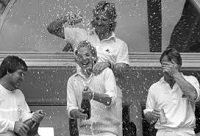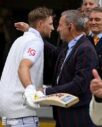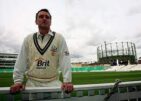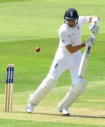Ashes ’85: Gower’s Glory
Gareth Bland |
England returned home from India in the spring of 1985 with morale substantially improved from that of the previous summer. A 2-1 series victory over Sunil Gavaskar’s Indian side had been achieved minus Ian Botham, who had chosen to spend the winter at home resting. Additionally, the victory had been gained by a side who had gone 1-0 down after the first Test. Coming from behind – no mean feat away from home – had also briefly allayed doubts about David Gower’s leadership.
England had more to look forward to, of course. From the beginning of the 1985 domestic season the selectors were able to choose from those players who had served their three year bans after touring South Africa in 1981/82. While some of those players were already long in the tooth or had retired, England had, in reality, one of the world’s finest opening batsmen to choose from in Graham Gooch and possibly the world’s finest off-spinner in the person of John Emburey.
Given three years of discomfort at watching what many believed were a series of makeshift opening batting partnerships, many of those in the White Rose county and beyond hoped that a certain 44 year-old Yorkshireman might also be returned to national colours. It was not to be, however, and Geoffrey Boycott would not improve upon his 108 Test Matches. As it was, England looked set to rebuild while consolidating on the turnaround achieved during the previous winter. Botham returned fresh, while Mike Gatting’s maiden Test century in India meant that, at the age of 27, the faith in his evident class had at long last been repaid.
The Australian squad that arrived in London contained many unfamiliar faces. Retirements and Rand-induced defections meant that Allan Border’s team contained a mixture of veterans who had seldom enjoyed so much as a look in since the late 1970s, and newcomers who the captain and Australian selectors hoped would form part of a new generation. Of the former, opening bat and Vice-captain Andrew Hilditch, having returned to the national team in the Australian summer of 1984/85 against West Indies, had last played international cricket in Mumbai in November 1979. However, his 113 out of a team total of 198 against Lloyd’s team in Melbourne months earlier was evidence of no lack of bravery. Batting intelligence, as events would go on to prove, was quite another thing all together.
Joining Hilditch was the craggy leg-spinner Bob Holland, then 39, who had debuted against West Indies in Sydney months earlier. Using an SCG turner to considerable effect, “Dutch” Holland had shot out the Windies to win the game, thus effectively booking his passage for England into the bargain.
David Boon, Simon O’Donnell and Craig “Billy the Kid” McDermott all had minimal experience. Wayne Phillips, too, as keeper-batsman had made his bow in 1983/84 and was similarly new to cricket observers across the British Isles. Joining this mixture was a legend of Australian supremacy from an earlier decade. Still capable of speed and disconcerting lift, if a little less often at the age of 35, was Jeffrey Robert Thomson. So different was the composition of this Australian squad that only three of the regular starting XI, in Border, Lawson and Wood, had toured the same shores in 1981.
With a top three comprising Hilditch, Graeme Wood and the crab-like Keppler Wessels, the top-order had an anxious, laboured look to it. Greg Chappell had retired and Hughes, Dyson, Hookes, Kent and Yallop were all absent for different reasons. Lacking the flare of previous Aussie lineups, two relative newcomers stepped in to fill the lacunae. First came a dashing keeper-batsman from South Australia, Wayne Phillips. If not perhaps immaculate in his glovework, his left-handed strokeplay was clean and stylish. His relaxed air also made him popular with both Australian and opposing fans. The other, an equally stylish Queenslander, had made his debut in 1982/83 against Pakistan. Nicknamed <i>”Fat cat”<i/>, Greg Ritchie had the build of a Milburn but the touch of a Cowdrey. No less a judge than David Frith eulogised the Ritchie cover drive as being the equal of anything he had seen in the previous quarter century.
After an entertaining start to the international summer at Old Trafford and Edgbaston, where Australia posted narrow victories in the first two one-day internationals, worries still remained about the England captain’s form. At Lord’s on Monday 3rd June all worries dissipated. If ever a player’s whole summer revolved around one incident it was surely the skied chance that David Boon presented to Gower deep into Australia’s 254-5 early in the afternoon. As the ball swirled in the air, Gower steadied himself and somehow clung on to the chance. David Gower was revivified. As he walked through the Member’s End following Tim Robinson’s early dismissal and out on to the field he was a different man. He accompanied Gooch in adding 212 as England strolled home with ease. Gower’s 102, and Gooch’s unbeaten 117 assuaged fears about the form of the England batting line-up. The six Test series beckoned with the opening encounter up in Leeds.
When Australia ran up a total of 331 in the first innings at Headingley, it was unclear whether this would be enough. Andrew Hilditch opened up with 119 which included 17 fours and 2 sixes, supported by a middle order who all made contributions but who each failed to pass 50. The Leeds surface looked less seamer-friendly than at previous encounters, but the deep England batting line-up responded magnificently. Mainstay of the innings was Nottinghamshire’s Tim Robinson. Debuting the previous winter after county team-mate Chris Broad had unluckily been left at home, Robinson continued his winter plunder with a smooth 175. Gatting and Lamb chipped in with cameos but none was as dramatic as Botham. Thundering from the pavillion as Richie Benaud announced him as “Yorkshire’s favourite foreign son” Botham got to 60 in a partnership of 80 with Robinson. Hitting 10 fours and 2 sixes, Botham looked like running amok yet again until he late cut Thomson into his stumps. England’s final total of 533 appeared daunting.
202 behind on the first innings, Australia’s second knock was indebted once more to Hilditch, who made 80, and to Wessels who combined with his vice-captain in adding 144 for the second wicket. The star of the second innings was Wayne Phillips, though. A crisply struck 91 included 12 fours, although in the end he fell to Botham, edging the all-rounder to Lamb 9 runs of a well-deserved century. Emburey’s comeback Test resulted in him claiming 5-82 in the second innings.
It took England 39 overs to reach their total of 123 in which time they had lost 5 wickets. Willey and Lamb were there at the end, although the converging crowd as Lamb mis-hooked Lawson into the deep to snatch the winning runs was a “disgrace” according to Richie Benaud in the commentary box. Unsurprisingly, Tim Robinson’s first innings 175 ensured that he took the man of the match award.
Headquarters beckoned for the second Test of the summer as Australia looked to capitalise on their historical supremacy at Lord’s. Allan Border won the toss and put the home side into bat. Despite a scintillating 86 from Gower – shades of things to come – Mc Dermott’s promise came to fruition as he claimed 6-70. The Australian reply of 425 gave them a first innings lead of 135 with the fulcrum being the captain himself. Dropped on 87 by Gatting at short-leg, Border advanced to 196. His pre-Test form had been Bradmanesque. With four centuries before the ODIs even began, he did not look like a man who was overawed by captaincy as was the case with his predecessor. If Border took the plaudits, then Greg Ritchie won marks for artistic merit. In a partnership of 216 with his State team-mate and national team captain, Ritchie’s execution of the straight and square drives, along with the cover drive, had classicists purring.
England fared little better in their second innings as an odd move by Gower to promote two night-watchmen, in Emburey and Allott, meant that Lamb and Botham came in at 7 and 8 respectively. That said, Botham’s thundering 85 was the highlight of a disappointing innings. Like England at Headingley, Australia made hard work of chasing down a relatively small total. With Botham revved up and bowling at speeds not seen in years, the tourists limped home to victory at 127-6, captain and man of the match Border there at the end with 41.
Two drawn Test matches followed, at Trent Bridge and Old Trafford, where the weather looked like spoiling the series. At Nottingham England won the toss and Gower elected to bat, where the captain’s 17 boundary 166 ensured he collected the man of the match award. England’s 456 was upstaged by the Australian 539 as Graeme Wood and Greg Ritchie compiled centuries in different styles. Botham continued to bowl aggressively – a little too aggressively, for Umpire Alan Whitehead’s tastes – while seam back up from Arnie Sidebottom and Paul Allott proved ineffectual on a placid Trent Bridge surface. With Emburey and Edmonds getting through 121 overs between them, the Australian innings was a long, hard slog for England.
At Old Trafford for the fourth Test David Gower opted to field on winning the toss, a decision vindicated by Australia’s all-out 257 on the opening day. In reply, Mike Gatting followed up his maiden overseas centuries in India with a first on home soil as he struck 160. In a 156 partnership with Allan Lamb, Gatting was severe on the drive and cut, striking 22 fours. An eventual 482 gave England a lead of 225. An Australian second innings 340-5, thanks largely to Allan Border’s unbeaten 146 and some dodgy weather, ensured a second consecutive drawn game.
The fifth Test at Edgbaston began on Thursday, 15th August. Botham’s extra zip with the ball during the previous Tests had been a revelation, but the selectors and captain were frustrated at his lack of penetrative seam back-up. As a consequence, out went Allott and Agnew from the previous game (as, indeed, Arnie Sidebottom had only lasted for one Test at Trent Bridge, and Norman Cowans just one at Headingley) and in came Leicestershire pace man Les Taylor and Kent’s medium-fast swing bowler Richard Ellison. The workload shared by Middlesex spin-twins Emburey and Edmonds during the games at Nottingham and Manchester had been immense and it was hoped that an infusion of speed and swing would rebalance the attack
Gower again chose to field on winning the toss, while Australia’s 335 saw steady contributions from Hilditch (39), Wessels (83), Border (45), Lawson (53) and McDermott (35). That England surpassed Australia’s first innings total for the loss of just Gooch was the result of a wild, sun-drenched Saturday. Robinson, correctly and watchfully, and Gower, flamboyantly and, well, “Gower-like”, ground down the Australian bowlers to such an extent that both McDermott and Thomson were plundered for more than 5 runs per over. Closing the Saturday on 355-1, the onslaught continued on the Monday in very different conditions. Heat, light and haze had given way to murk and damp as Gower and Robinson continued where they had left off. When Robinson departed at 369-2 in came Gatting. He and Gower took the score to 463 before Gower was dismissed for a majestic 215. With 25 fours and a six this was his highest Test score and would remain so for the remainder of his career; a languid testament to the summer of his international peak . Lamb joined Gatting and the innings then took on rarified proportions.
When Lamb was fourth out at 572 following a jaunty little knock of 46, Ian Botham descended the pavilion steps. Seven deliveries later he was dismissed for 18. From his first ball, a well pitched-up, good length ball from McDermott that arrowed in on middle stump, Botham contrived to fashion the perfect lofted straight-drive for six. Even those used to his feats of hitting were left incredulous. During a summer when he struck a then record number of sixes in the first-class game he looked like Jessop incarnate. A text book forward prod followed before Botham replicated his first delivery with another huge straight six. A crashing pull for four followed before, eventually, Thomson clung on to another Botham swing to leg off the suffering McDermott. Mike Gatting then completed another hundred leaving England 595-4 at the declaration.
With Australia going in a second time, Hilditch hooked Botham to deep square leg, just as he had done at Lord’s. His dismissal precipitated a collapse that rendered the game almost done on that Monday afternoon. The ace in England’s pack this time was Ellison, whose swing and close-in delivery proved Australia’s undoing. The killer blow was the dismissal of Border. The Australian captain played all round a ball that swung in late from outside off stump, shaping as if he was patting back a straight half-volley. The ashen look on his face as he trudged back was that of a man who knew the game was up. Australia closed at 37-5 on that fourth afternoon.
Bad weather almost thwarted England on that final day. Intermittent showers and spells of bad light meant for an on-off experience for much of the morning and early afternoon. When England did prevail it was thanks to a huge slice of luck. Having progressed without incident to 113 from an overnight 37-5, due largely to clean hitting from Phillips who sped to 59, the ‘keeper then attempted a crashing square cut off the bowling of Phil Edmonds. Cleanly executed, the ball hit the instep of an Allan Lamb recoiling in self-preservation at forward short-leg, where it was then pouched by Gower close in. Following lengthy deliberations between umpires Constant and Shepherd, Phillips was adjudged caught Gower bowled Edmonds. Thirty years on debate about the dismissal still rages. Looking back on the incident in 2005, Wayne Phillips remembered:
“I remember it vividly; it was never out. They set some really aggressive fields as they were looking for a wicket but we were doing well and then I was out. It was a real pain in the arse. I remember Edmonds bowled, I hit it into the ground, it bounced up, hit Lamb’s boot and then looped up to Gower who caught it. Botham was adamant it was a catch while Lamby was hobbling around struggling with his leg. Shep consulted David Constant. He then looked at me and said: “Flipper, you’re out.” David Shepherd is obviously still haunted by it as it has just finished his career 20 years later. It has clearly plagued him. Good old Shep”
Following that dismissal England’s victory was in the bag. 113-6 became 142 all out and England went 2-1 up with one Test to play at the Oval. Richard Ellison, man of the match for a 10 wicket haul that came at a cost of just 104 runs, revealed he had almost not played in the first place:
“When we got to Edgbaston I was advised not to play by Bernard Thomas (England physio) as I had a heavy cold. He thought I would not get through five days. The decision was left to me and I thought, as I had come this far, then why not”
The final Test of the summer arrived on 29th August. In sublime conditions Gower elected to bat after winning the toss yet again. When Robinson was yorked by McDermott with the score at 20 Gower joined Gooch. The returning Essex opener, whose own form throughout the series had been indifferent while his team-mates had plundered, looked to be suffering from the weight of expectation. In this innings he was about to put that right. Joining him with the score 20-1, Gower left Gooch still at the crease with the score 371-2. It had been a scintillating afternoon. Gower played one of his finest innings for England, hitting 20 fours in his 157. At the other end, Gooch came good at last. His 196 contained 27 fours before it ended to a soft caught and bowled dismissal at the hands of McDermott. England’s eventual 464, however, was considerably below what had earlier been expected as McDermott and Lawson mopped up a limp tail.
In reply, despite every batsman getting a start, Australia posted just 241. Having lost Wood at 35 Hilditch fell, once more, to the bouncer with the score on 52 as Graham Gooch pouched the mistimed and misdirected hook at deep fine-leg. The Australian second innings was then wound up for just 129 as Border contributed 58, with only Phillips and Murray Bennett among his team-mates reaching double figures . Ellison followed up his glorious Edgbaston debut with 5-46 in the second innings here. In the end England proved too strong for Border’s struggling Australian outfit, running out easy 3-1 victors in the end.
The 1985 Ashes series told us different things about England and Australia. One side had welcomed back international class performers who augmented a fully rested all-rounder and a captain who had the summer of his life with the bat. The other, Australia, were led by a captain who was in similarly mesmeric form with the bat, albeit one who was stylistically very different. For the victorious England team, however, the result proved to be something of a false dawn to say the very least.
Gooch, despite some fretful initial forays back in the international arena, proved his true class with a big 196 in the final Test. Then 32, he would ultimately get better and better and better. Emburey, also 32, would eventually end up Vice-captain to Gatting a year later on the tour to Australia. The captain, Gower, enjoyed his finest summer as an England player. Amassing 732 runs at 81.33 in his own unmistakable style, this was, as Ed Smith has observed “High Gower”. At the mid-way point in his 14 year England career Gower was never so glorious or as effective as he was that summer. Then 28, the image of him square driving, sun-hatted, on the Saturdays of the Edgbaston and Oval Tests that year are among the most indelible images of Gower’s playing days .
The other superstar, Ian Botham, enjoyed his last great home summer in an England shirt during 1985. Though we did not know it, he would never participate effectively in a full international summer again. Although he played in all 5 Tests of the 1987 home series against Pakistan, his most noteworthy contribution that summer was a rearguard 51 in the final Test at the Oval. The Ashes summer of ’85, then, was effectively Botham’s swansong on the home front at the age of just 29. He had batted effectively and scored his runs quickly, hitting 250 at 31.25. The killer statistic, though, is the rate at which those runs came: 86.50. With the ball he had not looked so consistently sharp since Edgbaston in 1981. A 1985 return of 31 wickets at 27.58 showed he still possessed sting and penetration when he needed to show it.
Mike Gatting, eight years after debut, and despite suffering from both a tendency to get out when well set and from selectorial whim, had finally arrived. During the Ashes summer of 1985 he totalled 527 at 87.83 and, emboldened by the vice-captaincy, looked to be a permanent fixture at last. Ultimately, then, 1985 had been a good Ashes series for England. The captain and selectors were justifiably proud and buoyant, and looked forward – if that is the correct phrase – to the winter series ahead. On the Oval balcony on 2nd September with the Ashes under his belt, his curly locks covered in a mixture of Castlemaine XXXX and Veuve Clicquot, the England captain even ventured as to imagine the winter’s opponents “quaking in their boots”. It did not, of course, quite turn out that way.
For Australia, things would get worse before they got better. Defeats in home series against both India and New Zealand prompted the Australian Cricket board to sanction the position of full-time coach in early 1986. They appointed a man who had come to his country’s rescue on previous occasions, most notably in 1977-78 when, as a 41 year-old, he led a young team to the Caribbean as captain. That man, Bobby Simpson, gave the Australian team its modern hard edge. Recognising that the rugged qualities of the Ian Chappell era had skipped a generation, Simpson sought to restore it and, with his on-field proxy Allan Border, ensured that it swept all before them. Some players would drop by the wayside in the process, unable to live up to Simpson and Border’s exacting demands. One player who did succeed, and who became perhaps the very embodiment of the Simpson era, was singled out by Wisden in its summary of the 1986 New Zealand series. A quiet, unassuming New South Welshman, then just 20, “already looked an accomplished all-round player” it concluded. It was Stephen Waugh, along with a like-minded band of tough-nuts, who would succeed Border and continue to shape a new Australian dynasty, expunging forever the debacle of 1985 and the handful of years that preceded it.





I have – perhaps too much based on the old Wisden Cricketers’ Almanacs which I absorbed upon initial reading in the 1990s – long held the view that the 1985 Australians were by far the worst Australian team to ever tour England, and one off the worst (excluding new Test nations) to tour England during at least the last third of the twentieth century.
The 1986 Wisden was bitterly critical of their batting technique and their bowling, which was handicapped by the loss of two of their best bowlers in Terry Alderman and Carl Rackemann to a planned tour of South Africa. Even ignoring that criticism, a 3—1 loss to an England team that during the six seasons from 1984 to 1989 won no other home Test except against Sri Lanka does not say much for the 1985 Australians. The poor quality of the opposition has made me feel the 1985 Australians would have been unlikely to match some earlier tourists beaten more decisively by superior England opponents (1978 Pakistanis, 1974 or 1967 Indians). To find a tourist definitely worse than the 1985 Australians (new Test nations excluded) one would have to go back to the 1962 Pakistanis who lost 4—0, the 1959 Indians who lost 5—0, and the “spare the rain and spoil the batsman” 1958 New Zealanders who lost only 4—0 but averaged an appalling 12.40 runs per wicket over five Tests. Whilst the 1958 tourists are often thought of as the worst to ever tour England, unless contemporary comments from Don Bradman and Ashley Mallett be entirely wrong, Lloyd’s 5—0 1984 West Indies would except in dry summers have had no chance of beating the genuine finger spin of Laker, Lock and others on the uncovered wickets of the 1950s. In fact, I have with age come to see the 1958 New Zealanders as a 1980s team (NOT a GOOD 1980s team) playing in the 1950s. How much worse the 1958 New Zealanders were than the 1985 Australians is uncertain given the difference in pitches and opposition is so much greater than in the teams.
Comment by Julien | 5:26am GMT 9 December 2018